New Native Shade Perennials for 2011
Carolyn’s Shade Gardens is a retail nursery located in Bryn Mawr, PA, specializing in showy, colorful, and unusual plants for shade. The only plants that we ship are snowdrops and miniature hostas. For catalogues and announcements of events, please send your full name, location, and phone number (for back up use only) to carolyn@carolynsshadegardens.com. Click here to get to the home page of our website for catalogues and information about our nursery and to subscribe to our blog.
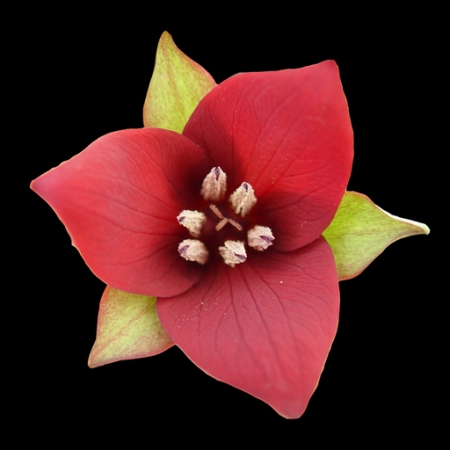 Sweet Wakerobin, Trillium vaseyi: I saw this trillium last spring in a local garden and fell in love with its large red flowers and huge bright green leaves; native species to just south of PA (photo Arrowhead Alpines).
Sweet Wakerobin, Trillium vaseyi: I saw this trillium last spring in a local garden and fell in love with its large red flowers and huge bright green leaves; native species to just south of PA (photo Arrowhead Alpines).
In my previous article, New Shade Perennials for 2011, I highlighted some of the new non-native plants I will be offering at my nursery this year. I also described my blog’s two audiences and my philosophy about what plants I grow in my gardens and sell at my nursery.
This article features some of the 17 native plants that are new (or returning) to my Spring 2011 Catalogue. For a full description of the ornamental and cultural characteristics of these plants, please consult my Spring 2011 Catalogue by clicking here or going to the sidebar of my homepage where it is permanently posted in more manageable chunks. For an illuminating (I think) discussion of why growing native plants is crucial to our survival, please read my article My Thanksgiving Oak Forest in which I profile Doug Tallamy’s book Bringing Nature Home.
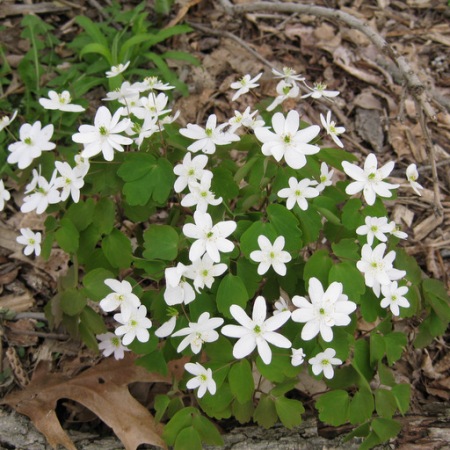 Rue-anemone, Anemonella thalictroides: an elegant wildflower that naturalizes in my dry woodland, I also grow single and double pink forms; native species to PA (photo Arrowhead Alpines)
Rue-anemone, Anemonella thalictroides: an elegant wildflower that naturalizes in my dry woodland, I also grow single and double pink forms; native species to PA (photo Arrowhead Alpines)
I am reluctant to enter the “what is a native plant” fray, but I feel I have to if I am going to use the word native to describe these plants. For the purposes of my catalogue, I treat all plants indigenous to the US and cultivars of and hybrids between those plants as native, always adding a comment on what part of the US the plant inhabits. Most of my natives are endemic to Pennsylvania and its immediate environs. However, many horticulturalists don’t consider cultivars and hybrids of native plants to be native.
To try and address that issue, I went right to the horse’s mouth and asked Doug Tallamy, author of Bringing Nature Home and Chairman of the Entomology and Wildlife Ecology Department at the University of Delaware, where he stood on native cultivars and hybrids.
 Prairie Trillium, Trillium recurvatum: native species to PA (Prairie?) and I think the easiest trillium to grow (photo Arrowhead Alpines).
Prairie Trillium, Trillium recurvatum: native species to PA (Prairie?) and I think the easiest trillium to grow (photo Arrowhead Alpines).
In responding, Tallamy first pointed out that: “We know very little from experimental data [because] comparisons just haven’t been done yet” between the ecological value of native plants and the value of their cultivars and hybrids. “Insects have adapted to the chemistry of their host plants, so if we don’t change the leaf chemicals too much when making cultivars, most of the insects that use the native parent should be able to continue using the cultivar.”
However, Tallamy cautions: “Most of our cultivars focus on flowers, … and flower energy budgets are very tight. If we make flower petals larger, that may come at the expense of nectar production…or pollen production. Pollinators will visit the new flower but get no reward. Double flowers typically have no nectar production at all…. A big down side of cultivars, even if they do support insects, is that they are clones with no genetic variation.”
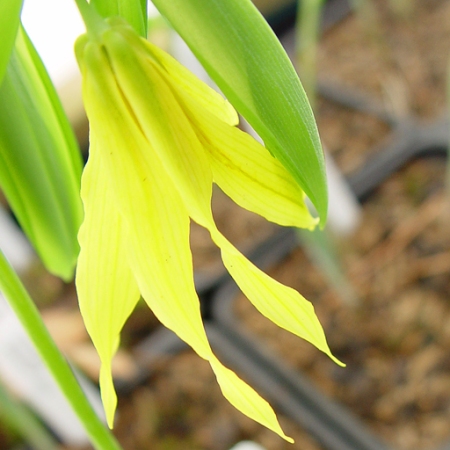 Large-flowered Bellwort, Uvularia grandiflora: it is really the full habit of this plant that grabs you in the garden with its many twisting flowers and leaves on upright stems; native species to PA (photo Arrowhead Alpines).
Large-flowered Bellwort, Uvularia grandiflora: it is really the full habit of this plant that grabs you in the garden with its many twisting flowers and leaves on upright stems; native species to PA (photo Arrowhead Alpines).
So how do I apply this to my new native plants? Well, of the 12 plants featured in this article, six are straight species native to Pennsylvania and its environs (see commentary under photos). These plants satisfy even the most narrow definition of native. The fern is a native hybrid that occurs naturally in the wild and should be as good as any straight species. The same can be said for the yellow columbine, which is a naturally occurring color variation. The double bloodroot, although double-flowered, was discovered and not created by humans. None of these are clones; they are all seed strains ensuring genetic diversity and vigor.
That leaves only the three heucheras described below. If your goal is to support native insects and through them the whole ecosystem, then purple-leaved heucheras like ‘Midnight Rose’ are not the plant for you. Tallamy says, “if [when creating a cultivar] we change a green leaf to a purple leaf, we are loading the leaf with anthocyanins, which are feeding deterrents for insects.” The same may be true of gold-leafed heucheras like ‘Electra’. Those two cultivars have also been created through extensive hybridizing of several heuchera species native to the US. ‘Green Spice’, however, is a cultivar of a species native to Pennsylvania and probably has leaf chemistry close to its parent and thus beneficial to native insects.
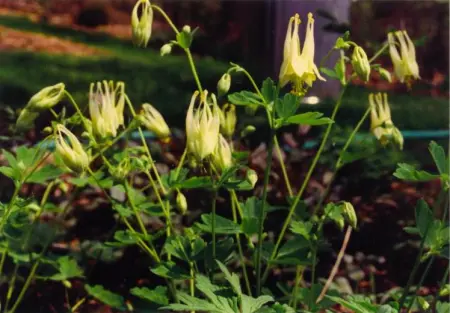 Wild Columbine, Aquilegia canadensis ‘Corbett’: pale yellow and shorter alternative to the bright red species and, like the species, does best in the well-drained but moist soil so difficult to find in my garden; naturally occurring color variation native to PA.
Wild Columbine, Aquilegia canadensis ‘Corbett’: pale yellow and shorter alternative to the bright red species and, like the species, does best in the well-drained but moist soil so difficult to find in my garden; naturally occurring color variation native to PA.
Where do I come out on all this? I really care about this issue so I try to have the majority of my property planted with straight PA native species friendly to native insects. I also think any plant with a native background even if it’s a “created” cultivar or hybrid is better than a non-native for supporting our environment. But I specialize in non-native hellebores and snowdrops, and I have hundreds of them in my garden. Balance in all things, including the garden.
Here are the rest of the new native plants I am excited about:
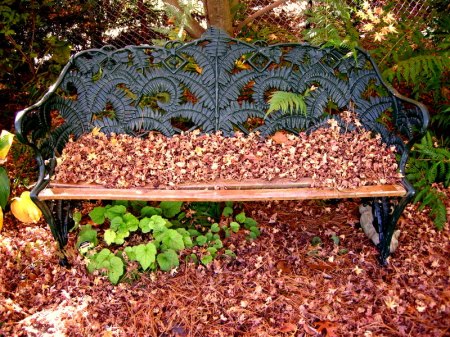 Dixie Wood Fern, Dryopteris x australis: a naturally occurring hybrid native to just south of PA, the fern growing behind and through my bench in the deep, dry shade of a Japanese maple overhung by a white pine is Dixie Wood Fern on 11/11/10—need I say more?
Dixie Wood Fern, Dryopteris x australis: a naturally occurring hybrid native to just south of PA, the fern growing behind and through my bench in the deep, dry shade of a Japanese maple overhung by a white pine is Dixie Wood Fern on 11/11/10—need I say more?
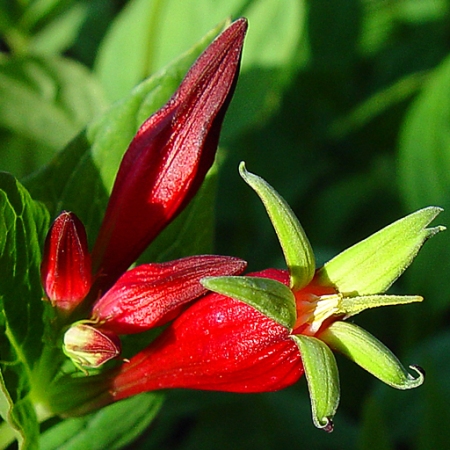 Indian Pink, Spigelia marilandica: there is no better way to get me going than to write yet one more shade gardening article that starts “Now you may not be able to have showy flowers in the shade, but….” ; native species to PA (photo Arrowhead Alpines)
Indian Pink, Spigelia marilandica: there is no better way to get me going than to write yet one more shade gardening article that starts “Now you may not be able to have showy flowers in the shade, but….” ; native species to PA (photo Arrowhead Alpines)
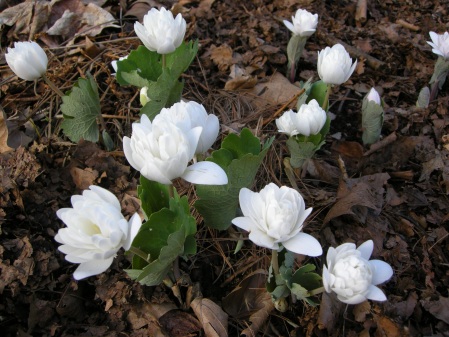 Double Bloodroot, Sanguinaria canadensis ‘Multiplex’: naturally occurring double flower native to PA, this is my all time favorite flower—I could stare at its perfection for hours—so it has taken me years to get to the point where I felt I had excess to sell!
Double Bloodroot, Sanguinaria canadensis ‘Multiplex’: naturally occurring double flower native to PA, this is my all time favorite flower—I could stare at its perfection for hours—so it has taken me years to get to the point where I felt I had excess to sell!
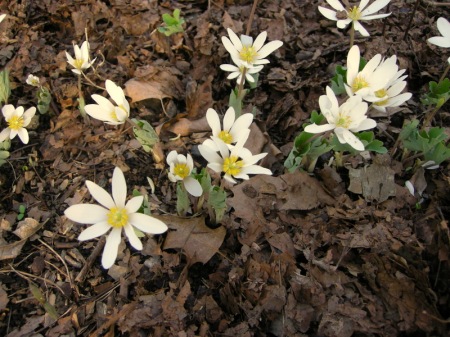 Bloodroot, Sanguinaria canadensis: so much to love, the way it spears through my leaf mulch, the unusual blue-green leaves, the pure white flowers, and, believe it or not, the short time they last in the garden—it forces me to savor them; species native to PA.
Bloodroot, Sanguinaria canadensis: so much to love, the way it spears through my leaf mulch, the unusual blue-green leaves, the pure white flowers, and, believe it or not, the short time they last in the garden—it forces me to savor them; species native to PA.
Who can resist the kaleidoscope of colors that heuchera leaves add to the garden and containers? If only all these beautiful plants thrived equally well in our tough mid-Atlantic conditions, but they don’t. I only sell the cultivars whose parents are the heat and cold tolerant heucheras native to the eastern US. Here are three new tough heucheras for 2011:
 Coral Bells, Heuchera x ‘Electra’: cultivar parented by two tough species native to PA and one Pacific Northwest species; with leaves and veins like this, who can resist? (photo Terra Nova Nurseries).
Coral Bells, Heuchera x ‘Electra’: cultivar parented by two tough species native to PA and one Pacific Northwest species; with leaves and veins like this, who can resist? (photo Terra Nova Nurseries).
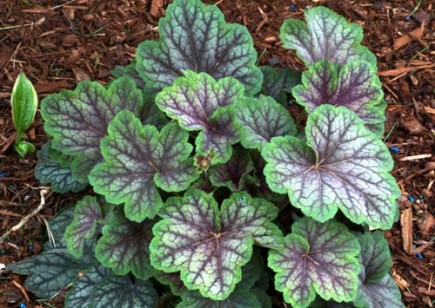 Coral Bells, Heuchera americana ‘Green Spice’: straight species cultivar created from our PA native so imminently suited to mid-Atlantic conditions, pumpkin orange fall color (photo Terra Nova Nurseries).
Coral Bells, Heuchera americana ‘Green Spice’: straight species cultivar created from our PA native so imminently suited to mid-Atlantic conditions, pumpkin orange fall color (photo Terra Nova Nurseries).
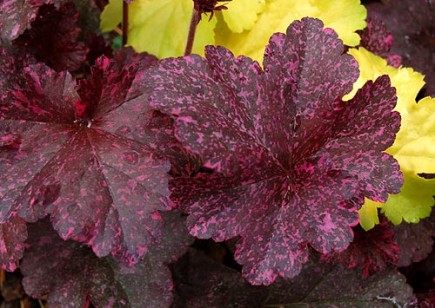 Coral Bells, Heuchera x ‘Midnight Rose’: cultivar parented by two tough species native to PA and one Pacific Northwest species; yes, it really looks like this and is a wonderful plant for containers, but requires a little more coddling in the ground because the Pacific Northwest species is more dominant in this cultivar (photo Terra Nova Nurseries).
Coral Bells, Heuchera x ‘Midnight Rose’: cultivar parented by two tough species native to PA and one Pacific Northwest species; yes, it really looks like this and is a wonderful plant for containers, but requires a little more coddling in the ground because the Pacific Northwest species is more dominant in this cultivar (photo Terra Nova Nurseries).
In addition to the above and what was covered in New Shade Perennials for 2011, I have new snowdrops, hellebores, and hostas, which will be covered in future articles on those topics.
Carolyn
Notes: Every word that appears in orange on my blog is a link that you can click for more information. If you want to return to my blog’s homepage to access the sidebar information (catalogues, previous articles, etc.), just click here.
The view from my desk this morning:
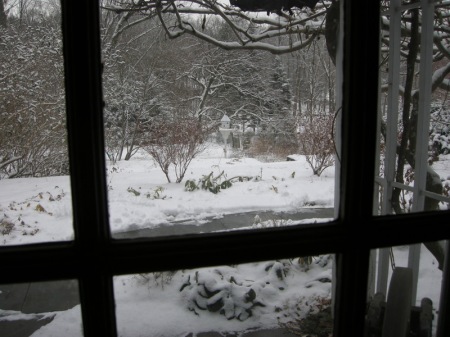
January 18, 2011 at 9:16 am
Fabulous post Carolyn . . . for its beauty and inspiration for thought regarding what we are doing with genetically modified plants. I think you are so right about balance . . . unless of course hybrids could become invasive. I love Hellebores and snowdrops and cannot imagine my garden without their ushering in spring. I think the fact that when we manipulate plants we alter the beneficial nectar production is one of the most important points against such manipulation. Creating clones, invasive plants or introducing non natives that overtake our native plants is equal in harm. If we consider this in our purchases, we might keep more of a balance for our beloved bees and butterflies. I so appreciate you as a nursery woman and plantswoman who cares deeply about these important issues . . . and for your reaching out . . . sharing your knowledge. I wish there were more nurseries like yours! I do so love seeing the bloodroot – I confess to preferring the single – for today there is snow falling with the promise of an icy ending. Your post is so uplifting.
January 18, 2011 at 9:32 am
Carol, Thank you for your kind words. I feel very fortunate that Doug Tallamy was willing to take the time to answer my questions so that I could pass this information along in a balanced way. I do really care about these issues, and Doug’s way of looking at them in his book has given me a much deeper understanding than the old standard “native is good”. I can now apply my new frame-of-reference in my garden and at my nursery. We woke up to an ice coated wonderland—so beautiful but so dangerous to the woody plants. Carolyn
January 18, 2011 at 12:18 pm
Carolyn, I am so thankful that you visited my site on GBBD so that I could find you. Your blog is so informative and beautifully written. With your Double Bloodroot and Trillium, you have me yearning for spring. I feel smarter after reading you post, and I will surely be back!
January 18, 2011 at 12:28 pm
Melanie, Thank you so much for the inspiring feedback. I enjoyed your GBBD post and am glad you came here. Carolyn
January 18, 2011 at 12:32 pm
There are so many benefits with the use of native and adapted plants. I agree that balance is the key to life and the garden and we can’t deny ourselves of the plants that we love and want in our garden.
Also, I can see why the Double Bloodroot is a favorite of yours…beautiful!!
January 18, 2011 at 12:54 pm
Amy, I added the double bloodroot to my catalogue with trepidation—do I need more than 50 in my garden—maybe I do. Carolyn
January 18, 2011 at 12:55 pm
Carolyn, so glad I subscribed to your posts, I would now not want to miss a single one. Your Trillium vasey looks amazing. I have a small woodland area which I am planting up and already have a few Trilliums. I normally clear the fallen leaves in early Winter as I have felt that some of the smaller plants would struggle to get through the carpet. What do you think? Personally we should cross the Atlantic just to be near your nursery.
January 18, 2011 at 2:12 pm
Alistair, Thanks for the kind words. I used to clear out all the leaves in my woodland garden, which is shaded by 100-year-plus London plane trees with large thick leaves and two black walnuts. The woodland ephemerals and natives in these gardens like trillium, European wood anemone,bloodroot, and rue-anemone looked too delicate to come up through a mass of soggy matted plane tree leaves. But then two years ago, I didn’t get to it because winter came too fast. And guess what, all the plants came up and were fine. So now I don’t clean it out at all. In the spring, I will remove unsightly leaves from my most precious patches of plants but no more total cleaning. You Scottish gardeners are so funny. You and Frances from Island Threads both want to move here to be near my nursery—to suburban Philadelphia from Scotland, which I fantasize as being one of the most ideal places to live and garden in the world?!? Think of the snowdrops that I could buy. Carolyn
January 18, 2011 at 2:34 pm
I don’t want to move to suburbia any where had enough of that, just want to be near a good nursery, like the one I used to buy from, I’m happy for them they retired but also had/have a sense of Oh no now where can I get my plants, I also have the problem being on an island that lots of companies won’t do mail order to us, why don’t you move to scotland :o) Frances
January 18, 2011 at 3:58 pm
Now you are thinking more clearly!
January 18, 2011 at 1:03 pm
a wonderful post Carolyn, I tried Trilliums in my garden as all the books etc. said they would grow in my conditions ~ they didn’t but they are not native here so I didn’t try again, I have quite a few native plants as like you and Carol I believe supporting the natural but I do have some non natives too, I used to buy my native plants and herbs from a good nursery on the mainland but they retired 2 years ago, I love all your wonderful leafmold a great mulch and food for your plants, Frances
January 18, 2011 at 3:40 pm
Frances, All the leafmold comes from leaves that we grind and use to mulch the beds. Trilliums are bulb-like plants that could easily be mishandled in storage if you bought them dry. Even if you bought growing plants, they never really recover from being stressed. I find that the easiest ones for me to grow are T. luteum, recurvatum, and cernuum (and its non-native counterpart whose name escapes me right now). Bob Stewart at Arrowhead Alpines assures me that T. vaseyi is as easy as any trillium, and I did see some beautiful local specimens. Carolyn
January 18, 2011 at 1:31 pm
Thank you for this shot of adrenaline. Whoever designed your site, to set off the photos so effectively, deserves praise.
Can you shed some light on the fact that some gardeners consider Heucheras to be short lived plants? I hope not, as they are one of my favorites for the shade garden.
January 18, 2011 at 3:53 pm
Allan, you really know how to flatter a person. I designed my site through WordPress and choose the colors to set off the photos. I almost had a nervous breakdown while doing it: the learning curve was a steep incline. If only I could change the color of the sidebar font, I would be so happy (my friend Kartik says it looks devilish), but that requires knowing CSS.
About heucheras: As you are well aware what seems like hundreds of heuchera cultivars have been indiscriminately introduced in the last ten years. They have been created from species native to very diverse areas of the US (and probably Canada). They all look gorgeous in the pots at the nursery center and that’s all a lot of nurseries know or care about. But a heuchera native to the Pacific Northwest is not going to grow well in the mid-Atlantic region, and they don’t, i.e., they are “short-lived”. I have also noticed that a lot of heucheras, even if they live, get woody and awkward and heave out of the ground easily, for example, ‘Palace Purple’. The absolute best heucheras for our area are the cultivars of Heuchera villosa (hairy alumroot) called ‘Citronelle’, ‘Caramel’, and ‘Frosted Violet’. They are big in size and leaf, come in gorgeous colors, have been going along nicely in my garden for 5 years and are pretty much evergreen. Hope that helps, Carolyn
January 18, 2011 at 1:47 pm
Sweet Wakerobin is so beautiful. I wonder if it would grow as far south as Alabama? We do have several species that grow here, and I have what I believe is trillium foetidissium growing in my woodlands. I also love those heucheras!
Non native invasives are a big problem for me. Many years ago bamboo and English ivy were planted on our property. We also have the monster kudzu. Of them all, the english ivy is the worse. It is hard to kill and harder to contain even than kudzu. I have plenty of non natives in my garden, but my awareness is much greater now. I keep an eye on them!
January 18, 2011 at 3:57 pm
Deb, The USDA plant profile (put T. vaseyi in Goggle) shows sweet wakerobin to be native to the whole state of Alabama. I sympathize. I have Japanese knotweed, goutweed, garlic mustard, lesser celandine, oriental bittersweet, …. sometimes it’s overwhelming. Carolyn
January 18, 2011 at 2:42 pm
So many beautiful blooms as always!
Loved the bench it looks great covered like that.
January 18, 2011 at 4:00 pm
Fer, I like that bench photo too. I have to get over to your blog to see your New Years Resolution Blog Carnival. I have already read some of the posts, and they are great. Carolyn
January 18, 2011 at 6:25 pm
Carolyn, wonderful photos of some wonderful plants. You highlighted two of my favorite spring natives the thalictrum and the bloodroot. Apparently there is a pink form of the thalictrum but I have never seen it in person. Did not think I would like the double form of the bloodroot but I do (I do prefer single forms in all plants, well, except peonies).
January 18, 2011 at 9:52 pm
Patty, I too usually prefer single flowers even in peonies, but the bloodroot is in class by itself. I have the rue-anemone in double and single pink, and I much prefer the single. Carolyn
January 18, 2011 at 7:53 pm
Aah, trilliums! The most magical of all flowers, and a plant that I’ve never grown, but admire perhaps above all others.
Beautiful post, Carolyn
January 18, 2011 at 9:54 pm
Alice, Do trilliums grow where you are, not sure? Carolyn
January 19, 2011 at 9:39 am
I love Trillium, Sanguinaria & Anemonella…and am trying to add more and more natives annually. I enjoyed some of your explanations and references to help get a handle on the definition of natives. It can be confusing, as I’ve found out by doing some of my own research. Heucheras are wonderful shade plants which I also love;-)
January 19, 2011 at 11:48 am
Jan, You love all my favorites. I am feeling much more centered about the whole native issue since I read Doug Tallamy’s book. Carolyn
January 19, 2011 at 10:56 am
How I yearn to grow some of these plants! I’ll be in Pennsylvania in mid-March – do you think there’s any chance I might see the double bloodroot or the rue-anemone in flower? I can’t decide which I love more…
January 19, 2011 at 11:46 am
Jill, Both of those plants were in bloom April 2 last year. We did have a late spring, but I think mid-March is a little early for them. Where will you be in Pennsylvania. I would love it if you stopped by my nursery—great hellebores and snowdrops then. Carolyn
January 20, 2011 at 4:13 am
Sorry I will miss the bloodroot and rue-anemone, but hellebores and snowdrops sound wonderful. I’ll be in Philadelphia (speaking at a UPenn conference). You’re not far from there I think, and it would be lovely to visit, but it’s a pretty packed programme and I won’t have a car. Maybe another time!
January 20, 2011 at 8:28 am
20-30 minutes from UPenn and public transportation easily available. Please keep in touch and maybe we can work something out.
January 20, 2011 at 3:16 pm
Will do. It would be fun to meet – and see some of your mouth-watering plants.
January 19, 2011 at 4:17 pm
What gorgeous plants-I would love to have all of them in my yard! I have a few shady places where I could create some woodland garden atmosphere… 🙂
January 19, 2011 at 6:31 pm
Well they are all great plants, and you can’t go wrong choosing any of them. Everyone needs woodland garden atmosphere. Carolyn
January 19, 2011 at 6:22 pm
I love this article!!! The majority of the plants in my garden are natives to either VA or the southeast. Spigelia is one of my favorites. It’s much tougher than its fragile appearance would suggest. I also grow anemone canadensis, which despite its name is native to most of the upper half of the US. This year I’m experimenting with two different diervillas. Fabulously informative article. Thank you so much for this post!!
January 19, 2011 at 6:43 pm
I would love to know how you grow your Spigelia. I planted it last year for the first time, and it was doing fine in the fall but hasn’t flowered yet—any tips? I tried Anemone canadensis but it seemed to spread more rapidly than I wanted so I got rid of it. Did you have this problem? I am only familiar with Diervilla lonicera, northern bush honeysuckle, which spreads in Maine quite rapidly. Carolyn
January 19, 2011 at 8:56 pm
Carolyn – My spigelia flowered last summer and I definitely didn’t do anything special! It’s in a moist acidic spot with high filtered shade. The spot wasn’t moist enough for lobelia siphlitica or astilbe but just fine for the blackberries. The diervillas I planted are diervilla lonicera and diervilla rivularis. They are for tough dry shady spots. It’s either give them a try or stick silk tulips in the ground!! :o)
January 20, 2011 at 8:23 am
I have been told by multiple sources that Spigelia is easy to grow, but I haven’t had a long experience with them so I continue to collect information. I hope the Diervilla lonicera has plenty of open space to expand and make a colony. It is beautiful if planted in the right place. Thanks for the additional info.
January 19, 2011 at 6:56 pm
Wonderful list of shade plants! I too love the Double bloodroot ‘Multiplex’.
The white blooms must really brighten a shade garden!
January 20, 2011 at 8:14 am
Ramona, They are exquisite and they last much longer because they are double. Carolyn
January 19, 2011 at 9:59 pm
Dear Carolyn, Wonderful post! You are so knowledgeable and I am learning much from you that I can apply to my shade garden. I echo Carol’s sentiments about the importance you give to native plants. I can’t wait to visit your nursery in the spring. P x
January 20, 2011 at 8:26 am
Pam, I am so excited to be in a position to spread Doug Tallamy’s message to more than one person at a time and to provide additional clarification. I feel like I can actually make a difference. As you can probably tell, I love writing and I love talking about plants too. Carolyn
January 20, 2011 at 8:17 am
Carolyn, thanks for again providing a inspiring plants and good food for thought. The Green Spice heuchera is new to me. I know that since you listed it,, that it must be a good plant. Is it vigorous enough to be used as a groundcover or is it better as a specimen?
Betsey
January 20, 2011 at 8:32 am
Betsey, I have listed ‘Green Spice’ based on my past experience with H. americana and because Joan (who works at my sales) grows it and has been asking me to offer it for about five years. For a ground cover, I would use bigger and even more robust heucheras like ‘Citronelle’, ‘Caramel’, or ‘Mocha’. Or try a few of the ‘Green Spice’ first and see how it goes. Carolyn
January 20, 2011 at 8:58 am
You have focused on many of my favorites, Carolyn, and those I don’t yet own, like Trillium vaseyi, crave!
January 20, 2011 at 9:03 am
Joey, I am looking forward to planting a few Trillium vaseyi in my own garden. That’s one of the advantages of owning a nursery. The disadvantage is that you never get to work in your garden. Carolyn
January 20, 2011 at 1:03 pm
Thanks for taking the time to get info from Doug Tallamy on native cultivars. I’ve heard people arguing (to the death) over this subject and his perspective sounds reasonable to me. I, like you, try to have a majority of natives (especially the ornamentals) with some noninvasive odds and ends thrown in.
January 20, 2011 at 1:19 pm
Eliza, I was very excited to get some clarification from someone who really knows what he is talking about rather than more diatribes from the partially informed. If we are going to make progress in this area, we need to be reasonable and balanced and set a good example with what we do in our own gardens. No matter how passionate we feel about the use of natives, it’s still an educational campaign. Carolyn
January 20, 2011 at 1:13 pm
Carolyn, I love the way you combined information about the plants you have available at your nursery with so much educational information on the use of native plants in the garden. I really, really appreciate your care and thoroughness about this. This post adds still more plants to the list of possibilities for my new woodland garden. (The problem isn’t going to be finding plants to include, it’s going to be whittling down that list so that I don’t end up with a one-of-this, one-of-that hodge-podge!)
January 20, 2011 at 1:26 pm
Jean, I don’t want any of my articles to be just a bunch of photographs so I search for a way to cleverly, I hope, interweave a topic with the plant info/photos. This topic is near and dear to my heart so I am trying to keep it before the public on Blotanical as long as possible. You had better not come to my nursery if your list is already that long: I have plants galore for woodland gardens. Seriously, I long ago abandoned planting perennials in ones or even threes. I patch of five is a minimum and seven is preferable. It is all about impact and low maintenance. From the photos I have seen of your garden, I think you do this too. Carolyn
January 21, 2011 at 1:38 am
Wow, I never knew there are actually so many colourful plants that can grow in shade. I become more optimistic now with my shade area which does not look that happy.
January 21, 2011 at 8:28 am
Diana, I started my business to provide a nursery where customers could find showy and colorful flowers to grow in the shade. I don’t know about Australia where you live, but here in the mid-Atlantic US it is possible to have lots of color in the shade. In fact, I view shade gardens as ideal because you can have glorious gardens but avoid the weeding that sun gardens require. Carolyn
January 21, 2011 at 3:35 pm
Perhaps this is a misconception on my part but I have a shade area I would love to turn into a shade garden but it does not get much moisture. When I go to the local garden centers, I find moisture loving shade plants. There must be something that can grow in the Carolina Pine forest that is not near a water source. The best luck I have ever had with the lovely shade plants is in low lying areas or around creek beds.
January 21, 2011 at 4:16 pm
Cheri, First of all, you can pretty much ignore the information on the plastic plants tags that come with shade plants. I find it is erroneous more than half the time. Even books and magazine articles routinely call for this mysterious “moist shade” so rarely found in the eastern US (maybe it is a denizen of the Pacific Northwest). There are plenty of shade plants that grow in full dry shade like a pine forest and some even thrive there. I would suggest reading through my catalogue on my sidebar or even printing it out. It’s like a mini-garden book. I will look into the issue of shade under evergreens more. Carolyn
January 29, 2011 at 11:50 am
I just found your site and am enjoying it. I am a big fan of shade gardening and am always looking for new varieties of exisitng plants. Your Coral Bells, Heuchera x ‘Electra’ look amazing. I have tried Heuchera ‘Amber Wave’ here in the northeast with little success. It just doenn’t seem to over-winter very well. I am hoping that this new cultiver is hardier. I have found that Heuchera ‘Palace Purple’ is the best survivor here but maybe there is hope for another cultivar! Thanks for the wonderful photos!
January 29, 2011 at 2:03 pm
Lee, When choosing coral bell cultivars, it is important to know what species they are derived from. You probably haven’t had much luck with ‘Amber Waves’ because it has a fair amount of H. micrantha in it, which is a species native to the Pacific Northwest, and it can’t take our heat. If you are looking for that amber color, I would suggest ‘Caramel’, which I think is even prettier with large leaves in caramel, peach, and pink tones. It is a cultivar of H. villosa, which is a heat tolerant species native to our area. An added bonus is its ornamental value for almost 365 a year (though how it’s faring under all this snow I don’t know). Carolyn
January 29, 2011 at 6:00 pm
Thank you so much Carolyn. You are extremely knowledgeable about Heuchera. We’ve had the ‘Amber Waves’ for sometime here in the nurseries and you’ve just explained the lack of hardiness perfectly. I will have to give ‘Caramel’ a try. I just LOVE the brightness of amber in the garden and along with ‘Palace Purple’ it will look gorgeous!
February 27, 2011 at 5:48 pm
[…] Can Sustain Wildlife with Native Plants by Douglas W. Tallamy (Timber Press, 2007) from a post at Carolyn’s Shade Gardens. Intrigued, I bought a copy of the book; and almost as soon as I began reading it, I was totally […]
April 7, 2011 at 12:24 pm
I am a home stager, preparing sellers’ homes for the real estate market. Because my organization promotes the use of native plants, I was browsing around doing some research for my Realtor newsletter readers. I decided to dig a little for my own purposes and found you by googling Delaware native shade plants. You sound like the answer to my prayers. Do you have offerings for shady yards that are partly wet? Our yard tapers down to a stream/storm runoff area.
April 7, 2011 at 1:55 pm
Peggy, Plenty of the native plants I offer are suitable for moist to wet sites. Pink turtlehead and cardinal flower come immediately to mind. Carolyn
April 14, 2012 at 9:04 am
Carolyn: I am looking for a garden designer or just a knowledgeable and skilled person to help me with a large graden in the Wynnewood area. Do you have any suggestions?
April 14, 2012 at 4:59 pm
John, Please email me with the specifics of what you are looking for. Carolyn
April 26, 2020 at 1:55 pm
Does aquilegia canadensis grow in full shade?
April 26, 2020 at 7:29 pm
No, I find that in my gardens it likes quite a bit of sun.